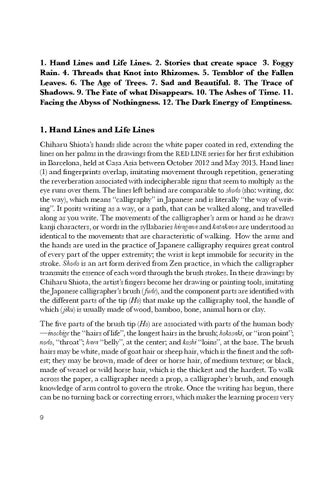1. Hand Lines and Life Lines. 2. Stories that create space 3. Foggy Rain. 4. Threads that Knot into Rhizomes. 5. Temblor of the Fallen Leaves. 6. The Age of Trees. 7. Sad and Beautiful. 8. The Trace of Shadows. 9. The Fate of what Disappears. 10. The Ashes of Time. 11. Facing the Abyss of Nothingness. 12. The Dark Energy of Emptiness.
1. Hand Lines and Life Lines Chiharu Shiota’s hands slide across the white paper coated in red, extending the lines on her palms in the drawings from the RED LINE series for her first exhibition in Barcelona, held at Casa Asia between October 2012 and May 2013. Hand lines (1) and fingerprints overlap, imitating movement through repetition, generating the reverberation associated with indecipherable signs that seem to multiply as the eye runs over them. The lines left behind are comparable to shodo (sho: writing, do: the way), which means “calligraphy” in Japanese and is literally “the way of writing”. It posits writing as a way, or a path, that can be walked along, and travelled along as you write. The movements of the calligrapher’s arm or hand as he draws kanji characters, or words in the syllabaries hiragana and katakana are understood as identical to the movements that are characteristic of walking. How the arms and the hands are used in the practice of Japanese calligraphy requires great control of every part of the upper extremity; the wrist is kept immobile for security in the stroke. Shodo is an art form derived from Zen practice, in which the calligrapher transmits the essence of each word through the brush strokes. In these drawings by Chiharu Shiota, the artist’s fingers become her drawing or painting tools, imitating the Japanese calligrapher’s brush ( fude), and the component parts are identified with the different parts of the tip (Ho) that make up the calligraphy tool, the handle of which ( jiku) is usually made of wood, bamboo, bone, animal horn or clay. The five parts of the brush tip (Ho) are associated with parts of the human body —inochige the “hairs of life”, the longest hairs in the brush; hokosaki, or “iron point”; nodo, “throat”; hara “belly”, at the center; and koshi “loins”, at the base. The brush hairs may be white, made of goat hair or sheep hair, which is the finest and the softest; they may be brown, made of deer or horse hair, of medium texture; or black, made of weasel or wild horse hair, which is the thickest and the hardest. To walk across the paper, a calligrapher needs a prop, a calligrapher’s brush, and enough knowledge of arm control to govern the stroke. Once the writing has begun, there can be no turning back or correcting errors, which makes the learning process very 9
